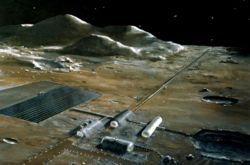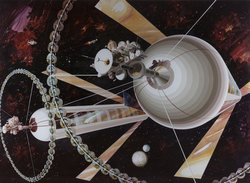| << Page in early stages >>
|
 Main Page > Colonising Space > Space habitats Main Page > Colonising Space > Space habitats
 Inside a large landscaped cylindrical habitat (credit: Eric Bruneton) Space is a very harsh environment and it may be hard to imagine wanting to live in such a seemingly bleak place, but taming it is only a matter of some (admittedly fairly serious) engineering and is entirely within our current technical capability.
There are many challenges to enable building these towns and cities off-Earth. Two prominent ones are raw materials and gravity. A colony of any size will have to be self-sufficient in materials as it will not be practical to ship them up from the surface of the Earth due to the enormous energy required to climb against its pull. Escaping this pull long-term also causes major problems for the human body. Muscles get very weak, including the heart, and bones de-mineralise. The only real solution is to generate artificial gravity by rotation – even for Moon-bases if people are going to stay for any length of time.
To balance these difficulties, living in space brings many advantages. One is reliable, abundant solar energy, not blocked by the atmosphere or subject to weather or time of day. Another is control of gravity; a rotating space colony would have normal Earthlike gravity at the periphery and zero gravity at the center. Large-scale construction and other industrial activities could be done at the center, reducing the energy they need to almost zero. When we build space habitats, we have the opportunity to tailor-make ecosystems that are optimized for human habitation. A space colony could be kept at any desired temperature, have any desired weather conditions and any desired seasonal and diurnal cycles. Careful controls could keep pests from being introduced to the ecosystem, allowing significantly higher agricultural yields. Moreover, infectious diseases could be excluded from space habitats.
There have been many studies over the past thirty years to understand what kind of habitats could be built and what size constraints there are based on current engineering knowledge. Surprisingly in the 1970s the answer was that using bridge and ship-building techniques it would possible to build cylindrical mega-structures up to 30 kilometres long and 6 kilometres in diameter, with a single one able to comfortably house several million people. These habitats would be assembled in zero gravity, which would greatly reduce the energy costs for such large-scale engineering. Materials like carbon fiber have since allowed us to imagine safer, stronger, more efficient habitats. A more recent design for a space habitat is described here.
Being mega-scale engineering projects, it is not hard to see that similar techniques used in the habitat's construction could be used to make the interiors of these habitats be like beautiful places on Earth, such as rolling green English countryside. Some designs even have enough atmosphere inside them to make the sky appear blue.
A passion for space colonisation and a faith in its promise was evoked in thousands of people by an essay called Space Colonies: The High Frontier, written by Gerard O'Neill in 1976. The essay outlines a fairly modest proposal, using only technology then existing, to build a series of space stations orbiting the Sun and Earth. Materials would be mined from the moon, launched into space and assembled into space colonies. Launching material from the moon is an easy matter, as there is far less gravity and no air resistance. The first colony would require about as much building material as the world's biggest skyscrapers, and would become self-replicating, as each colony could be used as a factory to assemble the next. The network of space habitats could then expand to form a Dyson swarm (see below) which could house tens of trillions of people to an extremely high standard of living.
O'Neill sets out to challenge a fundamental assumption underlying all our thinking about mankind's resources: the assumption that "The material and energy resources of the human race are just those of our planet." His calculations show that by building such colonies with materials from the asteroid belt and the moon, we could create "a land area many thousands of times that of the entire earth", with ideal climate, temperature and conditions. This would certainly impact just about every pressing social problem we now face on Earth.
Material
 Lunar mass driver which could be used to launch mined material from the moon into lunar orbit using solar power. The moon is rich in titanium and aluminium, which could be used to build space colonies. It would be far too inefficient to build these huge structures from material brought up from the surface of the Earth, so for orbiting colonies near Earth it has been proposed to use material mined from the moon or near-Earth objects  (particular asteroids and comets) and transported to where it needs to be using solar powered mass-drivers (particular asteroids and comets) and transported to where it needs to be using solar powered mass-drivers  . See Resources in space. . See Resources in space.
Life support
To survive in space, a person needs a minimum of 1kg of oxygen, 0.5kg of dehydrated food and 3.5kg of water per day [1]. Shuttle flights simply bring all the food they need, and bring their waste back with them, but for permanent space habitats, it is necessary to find a way to produce food in space.
 Biosphere 2  was an attempt to make a closed ecological system on Earth. Mastering this is an important step towards building permanent space habitats. There have been several attempts on Earth to construct a closed ecological system  and we have learned a lot from these. If we can build a fully closed ecological system on Earth, there is no reason why we cannot do so in space. and we have learned a lot from these. If we can build a fully closed ecological system on Earth, there is no reason why we cannot do so in space.
Space settlements will not have the easy access to the large store of resources we have on Earth. For this reason, they will have to be models of sustainable communities without pollution, waste or unsustainable harvesting of materials. The technologies of sustainable communities on Earth and sustainable communities in space must be considered together; they both require non-polluting industry, circular resource-chains and sophisticated recycling.
Areca palm, Snake plant  and money plant and money plant  are exceptional for their ability to create clean, fresh air for people [2]. A human can survive in a sealed environment with just four plants like these. The application of this to space habitats is obvious. are exceptional for their ability to create clean, fresh air for people [2]. A human can survive in a sealed environment with just four plants like these. The application of this to space habitats is obvious.
Aeroponics, as discussed here, can be used to grow plants in space. An aeroponic greenhouse could easily provide all the air and food space-dwelling humans need. Conservatively, this would require 20m2 per person, perhaps as little as 5 m2.
Biophilia  is an important aspect of plant-based life-support systems. It is psychologically difficult to be surrounded by nothing but metal and machines for months or years on end, and psychological stability is a major issue on long-term space missions. Introducing a leafy, green, fresh stimulus to the space-dweller's sensorium is of immense benefit. is an important aspect of plant-based life-support systems. It is psychologically difficult to be surrounded by nothing but metal and machines for months or years on end, and psychological stability is a major issue on long-term space missions. Introducing a leafy, green, fresh stimulus to the space-dweller's sensorium is of immense benefit.
Places
'Islands' in space
 A pair of O'Neill cylinder habitats Some of the most feasible strategies for building space colonies involve building giant self-contained structures in the vacuum of space itself, rather than on some pre-existing heavenly body. Bernal spheres  , Stanford torus , Stanford torus  and O'Neill cylinders and O'Neill cylinders  described below fall into this category. described below fall into this category.
The first step to building such habitats would be to set up automated facilities on the moon to mine titanium and iron and launch it into space. A habitat could then be assembled in space, and used to manufacture another habitat, making them self-replicating. Using materials from the moon and asteroid belt alone, we could create artificial habitats with thousands of times the land area of Earth, able to comfortably accommodate tens of trillions of people.
Lagrangian points and Solar orbit
A Dyson swarm refers to a series of habitats build in space around the Sun. Lagrangian points  are points in the Sun's orbit where a colony could orbit stably, keeping a constant comfortable distance from the Sun and the Earth. are points in the Sun's orbit where a colony could orbit stably, keeping a constant comfortable distance from the Sun and the Earth.
Low Earth orbit
The easiest place to get to from Earth is low earth orbit, although due to the Earth's strong gravitational pull it requires enormous amounts of energy to bring material up from the surface and one could not be classed as self-sufficient here, however the views are pretty good. If we develop more efficient means of access to space than we currently have, low Earth orbit habitats become more feasible.
Geosynchronous orbit
In a geosynchronous orbit  the habitat would hover the same spot on Earth which would mean that one would have the same day / night cycle as on the surface which is an important consideration with human physiology. the habitat would hover the same spot on Earth which would mean that one would have the same day / night cycle as on the surface which is an important consideration with human physiology.
Lunar orbit
In lunar orbit the moon is within easy reach but the habitat will be subject to the Moon's two-week long day / night cycles which might not be to everyone's taste, although of course the normal light rhythms can be replicated internally with lighting.
Moons and planets
Base on Mars
Before we can think about terraforming Mars, we need to land some people on it and have them live there for an extended stay. The 'Mars Direct  ' plan has rigorously demonstrated that a manned mission to Mars has been possible since the 1990s for $20 billion (in other words, about 0.4% of the US military budget, over five years). ' plan has rigorously demonstrated that a manned mission to Mars has been possible since the 1990s for $20 billion (in other words, about 0.4% of the US military budget, over five years).
A team of astronauts on the surface of Mars for years would be able to fill in the blanks in our knowledge of the Red Planet. The plan to terraform Mars is based on the assumption that there is no native life there. Before terraforming begins, we would need to confirm this assumption, as it is not ethically acceptable to deliberately destroy an entire planet's biosphere. More precise measurements of the chemical composition of Mars would allow us to perfect our terraforming plan.
Terraforming Mars
Terraforming refers to re-engineering the environment of a planet to make it more like Earth, that is, more friendly to life. We have some enormous advantages on our side in terraforming Mars: firstly, Mars has plenty of water, carbon, oxygen (though this is bound up as carbon dioxide), secondly, as we shall see, Mars will almost terraform itself once we give it a nudge in the right direction.
To terraform Mars we need add four things: heat, oxygen, water and atmospheric pressure. Happily, these are all connected; if we add heat, the others fall into place.
Step one: greenhousing Mars
Mars has a lot of frozen carbon dioxide, especially at its poles. Robert Zubrin has calculated[3] that if we heat the planet just 4°C, some of this will sublimate into the atmosphere. This carbon dioxide is a greenhouse gas, which will lead to more warming, making the frozen carbon dioxide that remains at the colder parts sublimate, leading to more global warming. This will cause the frozen water below the surface to melt and some of it will vaporise. This water vapour is another greenhouse gas, leading to even more global warming. When the planet reaches higher temperatures, more carbon dioxide, trapped in minerals, will be released into the atmosphere. So an initial nudge of 4°C can set in motion a chain of events that raise the temperature of the planet 55°C and build enough atmosphere to raise the pressure from 0.006 to 0.296 atmospheres (similar to pressure at twice the altitude of Everest).
This whole process may take about 25 years. By the end of it, the average temperature of the planet is 0°C (though we can locate our colonies at places much warmer than average) and the pressure allows people to walk around without a spacesuit. The atmosphere is still nearly all carbon dioxide, so breathing apparatus will be required if colonists are to venture beyond sealed habitats. The planet is not fully terraformed, but we are off to a very good start and all it took was heating the planet 4°.
How do we create this 4°C increase? Ironically, the very scientific knowledge gained by studying the destruction of the Earth's biosphere can be applied to engineering a new biosphere on Mars; releasing enough CFCs or similar greenhouse gases into the atmosphere should do the trick. The building blocks of CFCs are available on the surface of Mars, and we could engineer some automated method of synthesizing them in-situ and releasing them into the atmosphere. About 39 million tons would be required, roughly three times what was produced on Earth during the 20 years CFCs were used in industry. Two other methods of warming the planet have been proposed: sending ammonia- or methane-rich asteroids to collide with it (these are greenhouse gases) or building gigantic mirrors in orbit to reflect more sunlight onto those frozen carbon dioxide deposits. Of the three methods, CFCs do seem the most feasible, but the other two may provide a helping hand. If a lunar mining colony is in place, launching a thin aluminium mirror of sufficient size would not be unfeasible.
Step two: life off-Earth
Once this process is complete, we must release the oxygen from carbon dioxide. The best way to do this would be with some automated technology that can perform the chemical processes necessary to split carbon dioxide molecules apart. Because it would take too much energy to build enough of these to transform an entire planet, the technology would have to be self-replicating, capable of colonizing the planet autonomously as it worked. Luckily, such a technology is already in existence: Life.
Some extremophiles have survived well in conditions that simulate current conditions on Mars[4]. But by the time we set about bio-terraforming the Red Planet it would have much more comfortable conditions: liquid oceans, an average temperature of 0°, and pressure about a fifth of Earth's. Many anaerobic bacteria, algae, fungi and lichens could survive there. Genetic engineering could be used, but would probably not prove necessary. Genetic engineering may create organisms that can release another reservoir of oxygen: that which is trapped in metallic oxides on the planet's surface.
This plan does not address one major difference between Earth and Mars: gravity. Gravity on Mars is only 38% of Earth's. This may be an obstacle to making Mars really Earthlike. We know that after enough time in zero-gravity environments, astronauts suffer degeneration of the muscular and skeletal systems, but we do not know what would happen in a reduced-gravity environment like Mars. All of Man's experience so far has either been at zero-gravity or Earth's gravity. If this turns out to be an insurmountable issue then homes and other living spaces could be built within very large diameter rotating structures on the surface to simulate 'Earth gravity'.
Venus atmosphere
There are formidable obstacles to establishing human life on the surface of Venus: the surface temperature is around 450°C and the pressure is around 90 atmospheres – equivalent to the pressure at around one kilometre under Earth's oceans. However, 50km above the surface of the planet we find Earthlike temperatures and pressures. It has therefore been proposed that the easiest way to establish a colony on Venus would be to fill a gigantic balloon with breathable air. Such a structure would float above the denser air of Venus in the same way that a helium balloon floats above Earth.
The gravity on Venus is 91% of that on Earth, so it is unlikely any special measures would need to be taken to create artificial gravity.
These floating habitats could also be equipped with devices to alter the atmosphere with the aim of eventually terraforming Venus.
Terraforming Venus
As noted above, the surface of Venus is a hostile place. However it has one big advantage: Earthlike gravity. If the heat, pressure and gaseous composition of the atmosphere can be changed through a terraforming project more radical than that on Mars, Venus could one day be settled.
Other moons
Many to choose from.
Enceladus around Saturn has H2O.
Europa around Jupiter has lots of H2O and O2. Underneath the ice are liquid oceans which may harbour life.
Titan around Saturn - Pressure of 1.45 atmospheres. Lots of atmospheric nitrogen, carbon (as methane) and H2O.
Asteroid Belt
Ceres
(Water ice)
Various types of habitat
- Stanford torus
- O'Neill cylinder
- Crater bubble
- Rotating moonbase for 1g
- Hollowed out asteroid
- Zero-G station
- Rotating dumbell
Further information
| 








